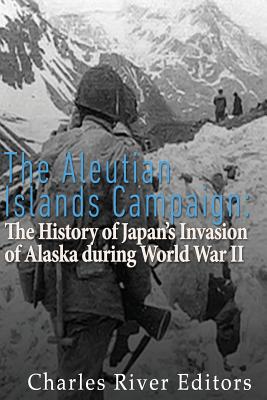The Aleutian Islands Campaign: The History of Japan's Invasion of Alaska during World War II

The Aleutian Islands Campaign: The History of Japan's Invasion of Alaska during World War II
*Includes pictures *Includes accounts of the campaign written by soldiers on both sides *Includes online resources and a bibliography for further reading *Includes a table of contents "It was United States territory. That's something you don't do. You don't come over and grab some of our land. So we had to take it back regardless of strategy. We couldn't just let them sit there. " - Admiral Robert L. Dennison, USN (Perras, 2003, 189) Fought over bitterly cold flecks of rock and tundra scattered across the remote waters marking the boundary between the Bering Sea and the Pacific Ocean, the Aleutian Islands campaign represented one of the strangest encounters of World War II. Curving southwestward from the southwest coast of Alaska like the tail of a stingray, the rugged, volcanic Aleutians belong to both the United States and Russia. The westernmost island, Attu, lies much closer to Russia's Kamchatka Peninsula than to Alaska; the distance to Anchorage, Alaska measures approximately 2,000 miles. The moral impact of the Doolittle Raid in response to Pearl Harbor far outweighed the relatively minor material damage it inflicted; Japan lost face and the faith of its people in ultimate victory declined sharply. Americans responded with delight and a fresh upsurge of hope. Despite interrogating the eight American aircrew they captured (and butchering tens of thousands of Chinese civilians in reprisal for assisting the rest in their escape), the Japanese leadership remained divided in their opinions about the bombers' origin. Many believed that the Americans had indeed devised a method of launching such large aircraft from an ordinary aircraft carrier. Many others, however, insisted the B-25s came from a land base, and only the Aleutians lay within a medium bomber's operational range. In any case, Admiral Yamamoto Isoroku planned a move against Midway. Attacking the Aleutians provided an excellent diversion, in his opinion, permitting him time to take Midway and organize land-based strike aircraft there. He could then take his carriers to annihilate America's Pacific Fleet, caught between the Aleutian Islands and Midway. Due to the belief that the Aleutian Islands might support the airfields from which the Doolittle bombers launched, Navy Order Eighteen from Imperial general HQ included a section decreeing "the invasion and occupation of the western Aleutians... in order to prevent enemy forces from attacking the homeland" (Garfield, 1978, 7). In the event, th
PRP: 79.36 Lei
Acesta este Pretul Recomandat de Producator. Pretul de vanzare al produsului este afisat mai jos.
71.42Lei
71.42Lei
79.36 LeiLivrare in 2-4 saptamani
Descrierea produsului
*Includes pictures *Includes accounts of the campaign written by soldiers on both sides *Includes online resources and a bibliography for further reading *Includes a table of contents "It was United States territory. That's something you don't do. You don't come over and grab some of our land. So we had to take it back regardless of strategy. We couldn't just let them sit there. " - Admiral Robert L. Dennison, USN (Perras, 2003, 189) Fought over bitterly cold flecks of rock and tundra scattered across the remote waters marking the boundary between the Bering Sea and the Pacific Ocean, the Aleutian Islands campaign represented one of the strangest encounters of World War II. Curving southwestward from the southwest coast of Alaska like the tail of a stingray, the rugged, volcanic Aleutians belong to both the United States and Russia. The westernmost island, Attu, lies much closer to Russia's Kamchatka Peninsula than to Alaska; the distance to Anchorage, Alaska measures approximately 2,000 miles. The moral impact of the Doolittle Raid in response to Pearl Harbor far outweighed the relatively minor material damage it inflicted; Japan lost face and the faith of its people in ultimate victory declined sharply. Americans responded with delight and a fresh upsurge of hope. Despite interrogating the eight American aircrew they captured (and butchering tens of thousands of Chinese civilians in reprisal for assisting the rest in their escape), the Japanese leadership remained divided in their opinions about the bombers' origin. Many believed that the Americans had indeed devised a method of launching such large aircraft from an ordinary aircraft carrier. Many others, however, insisted the B-25s came from a land base, and only the Aleutians lay within a medium bomber's operational range. In any case, Admiral Yamamoto Isoroku planned a move against Midway. Attacking the Aleutians provided an excellent diversion, in his opinion, permitting him time to take Midway and organize land-based strike aircraft there. He could then take his carriers to annihilate America's Pacific Fleet, caught between the Aleutian Islands and Midway. Due to the belief that the Aleutian Islands might support the airfields from which the Doolittle bombers launched, Navy Order Eighteen from Imperial general HQ included a section decreeing "the invasion and occupation of the western Aleutians... in order to prevent enemy forces from attacking the homeland" (Garfield, 1978, 7). In the event, th
Detaliile produsului








